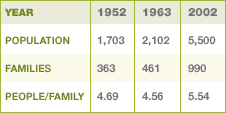Introduction
Population: Statistical data and people's activities
 Vicos is a Peasant Community (Comunidad Campesina), a corporate landholding body with legal status. There are more than 5,000 peasant communities in Peru representing 50% of rural population and 15% of the total population. Vicos has communal and family-controlled lands that cannot be sold. Reciprocity and kinship relationships are strong but kinship is no longer the major means of organizing labor.
Vicos is a Peasant Community (Comunidad Campesina), a corporate landholding body with legal status. There are more than 5,000 peasant communities in Peru representing 50% of rural population and 15% of the total population. Vicos has communal and family-controlled lands that cannot be sold. Reciprocity and kinship relationships are strong but kinship is no longer the major means of organizing labor.
Vicos Population Chart:

Credit: Urpichallay Association
 Population doubled between 1952 and 2000 and approximately, 5,500 people in 1000 families live in the community with around 70% of the population being younger than 30 years of age. Everyone speaks Quechua as their first language and most men under fifty and young people also speak Spanish. Families depend primarily on agriculture and herding for subsistence.
Population doubled between 1952 and 2000 and approximately, 5,500 people in 1000 families live in the community with around 70% of the population being younger than 30 years of age. Everyone speaks Quechua as their first language and most men under fifty and young people also speak Spanish. Families depend primarily on agriculture and herding for subsistence.
 On average, each family cultivates 6.5 acres of land and raises 24 animals. But cows are a special form of savings and each family raises 5 cows and sells a cow when they need cash. However, they keep bulls for plowing. But, Vicosinos neither specialize in cattle-raising nor milk or cheese production. Vicos is not a homogeneous community: there are differences in Vicosinos' socioeconomic statuses with land holdings varying widely in size and wealthier families possessing more animals.
On average, each family cultivates 6.5 acres of land and raises 24 animals. But cows are a special form of savings and each family raises 5 cows and sells a cow when they need cash. However, they keep bulls for plowing. But, Vicosinos neither specialize in cattle-raising nor milk or cheese production. Vicos is not a homogeneous community: there are differences in Vicosinos' socioeconomic statuses with land holdings varying widely in size and wealthier families possessing more animals.